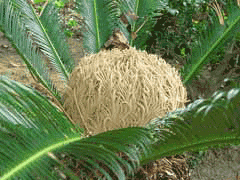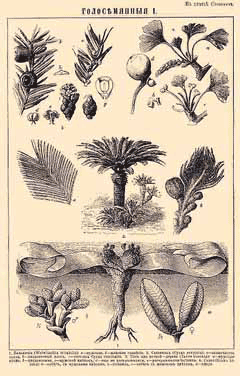 |
|
http://www.flickr.com/photos/tanaka_juuyoh/ |
 |
| http://commons.wikimedia.org/wiki/File:Cycas_revoluta00.jpg |
Translate this page:
Summary
Form: Palm.
Physical Characteristics

 Cycas revoluta is an evergreen Tree growing to 3.5 m (11ft) by 3.5 m (11ft) at a slow rate.
Cycas revoluta is an evergreen Tree growing to 3.5 m (11ft) by 3.5 m (11ft) at a slow rate.
See above for USDA hardiness. It is hardy to UK zone 9 and is frost tender. It is in leaf all year, in flower from May to July, and the seeds ripen from October to November. The species is dioecious (individual flowers are either male or female, but only one sex is to be found on any one plant so both male and female plants must be grown if seed is required). and is pollinated by Insects, wind. The plant is not self-fertile.
It can fix Nitrogen.
Suitable for: light (sandy) and medium (loamy) soils and prefers well-drained soil. Suitable pH: mildly acid, neutral and basic (mildly alkaline) soils. It can grow in semi-shade (light woodland) or no shade. It prefers dry or moist soil.
UK Hardiness Map
US Hardiness Map
Synonyms
Plant Habitats
Woodland Garden Sunny Edge; Dappled Shade; South Wall. By. West Wall. By.
Edible Uses
Edible Parts: Seed Stem
Edible Uses:
Seed - raw or cooked[2, 46, 177]. They can be dried and ground into a powder then mixed with brown rice and fermented into 'date miso' or 'sotetsu miso'[183]. Caution is advised, see the notes above on toxicity. The heart or pith of the trunk is sliced and eaten baked or powdered. A toxic principal must first be removed[183]. A starch can be extracted from this pith and is used for making dumplings[183]. It is very sustaining[2, 177].
References More on Edible Uses
Medicinal Uses
Plants For A Future can not take any responsibility for any adverse effects from the use of plants. Always seek advice from a professional before using a plant medicinally.
Astringent Cancer Diuretic Emmenagogue Expectorant Tonic
The leaves are used in the treatment of cancer and hepatoma[218]. The terminal shoot is astringent and diuretic[218]. The seed is emmenagogue, expectorant and tonic[218]. It is used in the treatment of rheumatism[218]. Substances extracted from the seeds are used to inhibit the growth of malignant tumours[218].
References More on Medicinal Uses
The Bookshop: Edible Plant Books
Our Latest books on Perennial Plants For Food Forests and Permaculture Gardens in paperback or digital formats.

Edible Tropical Plants
Food Forest Plants for Hotter Conditions: 250+ Plants For Tropical Food Forests & Permaculture Gardens.
More

Edible Temperate Plants
Plants for Your Food Forest: 500 Plants for Temperate Food Forests & Permaculture Gardens.
More

More Books
PFAF have eight books available in paperback and digital formats. Browse the shop for more information.
Shop Now
Other Uses
References More on Other Uses
Cultivation details
Landscape Uses:Border, Container, Massing, Seashore, Specimen. Requires a strong loam with sharp sand and good drainage[164]. Succeeds in dry soils. Requires a sunny position[188]. Although it is the hardiest cycad, this species is not fully hardy in Britain but can tolerate occasional lows to about -5°c so long as the crown is protected[200, 260] and so is worthwhile trying outdoors in a sheltered position in the mildest areas of the country[166]. Alternatively, it can be given greenhouse or conservatory protection over the winter and be placed outdoors in the summer[1]. Plants are very slow growing[188, 260]. This plant is often used as a food source in its native range but recent research has shown that it can cause chronic nervous disorders if it is not treated properly[200]. Overall its use is not to be recommended, especially since it is becoming rare in the wild. The plants produce special upward growing roots where nitrogen is produced in symbiosis with algae[200]. Dioecious, male and female plants must be grown if seed is required. Special Features:Attractive foliage, Not North American native, All or parts of this plant are poisonous, There are no flowers or blooms.
References Carbon Farming Information and Carbon Sequestration Information
Temperature Converter
Type a value in the Celsius field to convert the value to Fahrenheit:
Fahrenheit:
The PFAF Bookshop
Plants For A Future have a number of books available in paperback and digital form. Book titles include Edible Plants, Edible Perennials, Edible Trees,Edible Shrubs, Woodland Gardening, and Temperate Food Forest Plants. Our new book is Food Forest Plants For Hotter Conditions (Tropical and Sub-Tropical).
Shop Now
Plant Propagation
Seed - best sown in a greenhouse as soon as it is ripe, 2cm deep in individual pots which are then sealed in plastic bags to keep them moist until germination takes place. Germinates in 1 - 3 months at 25°c[164]. Pre-soak stored seed for 24 hours in warm water then treat as above. Division of suckers in the spring.
Other Names
If available other names are mentioned here
Native Range
TEMPERATE ASIA: China (Fujian Sheng), Japan (Kyushu, Ryukyu Islands)
Weed Potential
Right plant wrong place. We are currently updating this section.
Please note that a plant may be invasive in one area but may not in your area so it's worth checking.
Conservation Status
IUCN Red List of Threatened Plants Status :

Growth: S = slow M = medium F = fast. Soil: L = light (sandy) M = medium H = heavy (clay). pH: A = acid N = neutral B = basic (alkaline). Shade: F = full shade S = semi-shade N = no shade. Moisture: D = dry M = Moist We = wet Wa = water.
Now available:
Food Forest Plants for Mediterranean Conditions
350+ Perennial Plants For Mediterranean and Drier Food Forests and Permaculture Gardens.
[Paperback and eBook]
This is the third in Plants For A Future's series of plant guides for food forests tailored to
specific climate zones. Following volumes on temperate and tropical ecosystems, this book focuses
on species suited to Mediterranean conditions—regions with hot, dry summers and cool, wet winters,
often facing the added challenge of climate change.
Read More
Expert comment
Author
Thunb.
Botanical References
58200266
Links / References
For a list of references used on this page please go here
Readers comment